During my time at WPBeginner, I’ve seen firsthand how challenging content management can be. I remember those early days, constantly experimenting with different plugins, searching for a workflow that wouldn’t leave me feeling overwhelmed. If you’re in the same boat, I know the struggle is real.
My team and I are constantly testing new content marketing tools, always looking for the best solutions for WordPress. We’ve learned through trial and error which tools truly deliver on their promises and which ones fall short. We know that having the right tools isn’t just helpful – it’s essential for content marketing success.
That’s why we’ve invested the time to test countless options, carefully evaluating each one for its effectiveness and ease of use. We’ve narrowed it down to the 13 most impactful content marketing plugins for WordPress, the very tools we use every day at WPBeginner.
Whether you’re a beginner or you’re looking to refine your existing content strategy, this guide will provide you with the essential tools to create, optimize, and manage your content like a pro.

Overview of the Best Content Marketing Tools for WordPress
If you’re short on time, I’ve got you covered with a quick overview of the best content marketing tools and plugins for WordPress. Check out the table below for my top 10 picks from different categories.
| # | Content Marketing Tool | Best For | Pricing | Free Version |
|---|---|---|---|---|
| 1 | MonsterInsights | Understanding your content’s performance with detailed analytics | Starting at $99.60/year | ✅ |
| 2 | AIOSEO | Optimizing your content for better search engine rankings | Starting at $49.60/year | ✅ |
| 3 | PublishPress | Managing your editorial workflow + content scheduling | Starting at $129/year | ✅ |
| 4 | Semrush | Finding content ideas and analyzing competitor strategies | Starting at $139.95/month | ❌ |
| 5 | Canva | Creating engaging visual content without advanced design skills | Starting at $120/year | ✅ |
| 6 | ClickSocial | Automating and managing social media content within WordPress | Starting at $3.99/month | ❌ |
| 7 | Grammarly | Ensuring error-free and professional content | Starting at $12/month (per member) | ✅ |
| 8 | PushEngage | Bringing visitors back to your website | Starting at $8/month | ✅ |
| 9 | OptinMonster | Converting readers into subscribers and customers | Starting at $7/month | ❌ |
| 10 | EWWW Image Optimizer | Optimizing images to speed up your WordPress site | Starting at $8/month | ✅ |
I hope this table was helpful, but I still recommend reading the entire post so you can get the complete list!
Why Do You Need Content Marketing Tools and Plugins?
Creating great content that attracts and engages your audience is easier when you have the right tools. Successful content marketers use smart tools to create a content strategy that stands out and connects with their target readers.
From my experience, these powerful tools help you:
- Discover exactly what your audience wants to read.
- Create more engaging content that ranks better.
- Track what’s working on your blog and improve your results.
- Save time on content creation and promotion.
- Turn your content into a reliable traffic source.
The best part? These content marketing tools work together to help you build a better content marketing strategy that takes the guesswork out of content creation.
Whether you’re just starting or looking to grow your existing traffic, these tools will help you create content that resonates with your readers and achieves your goals.
How We Test & Review Content Marketing Tools for WordPress
I understand that choosing the right content marketing tools can feel overwhelming. That’s why my team at WPBeginner and I have taken the time to test each tool on actual WordPress sites to ensure they help you create and share better content.
Here’s how we evaluated the best content marketing tools:
- Simplicity. Your tools should make content creation easier, not harder. That’s why we picked tools that anyone can use without special training. For example, Canva lets you make great images with simple, drag-and-drop tools, while Grammarly catches writing mistakes as you type.
- Integration. Your content marketing tools also need to work well together. We checked if each tool works smoothly with WordPress and fits into how you already create content. The best tools connect easily with WordPress and don’t require complex setup steps.
- Functionality. Good tools should solve real problems. So, we also looked at how each one makes your content better – whether it helps with writing, images, SEO, or sharing.
- Value. While some tools on this list are free, others aren’t. We made sure that any paid tools are worth the cost. We also highlighted free options that work well for beginners.
- Use Cases. To be successful in content marketing, you’ll need tools in more than one category. So, we’ve picked different types of tools to cover all your needs. For instance, we looked for tools for analytics, SEO, lead generation, graphic design, and more.
Why Trust WPBeginner?
At WPBeginner, we’ve spent over 16 years mastering WordPress content marketing. Our team has created, optimized, and promoted thousands of articles that drive millions of monthly visitors.
What’s more, we don’t just recommend content marketing tools, we use them daily. For instance, we rely on AIOSEO to optimize on-page SEO and MonsterInsights to track conversions. We also depend on OptinMonster for popups, slide-ins, and header banners for special offers and deals.
Since we have so much hands-on experience with content marketing tools, we can confidently recommend our favorite options. And for any tools we don’t use regularly, we made sure to test them ourselves.
To learn more about how we test and review products, see our complete editorial process.
Now, let’s check out the best content marketing tools for WordPress!
1. MonsterInsights

MonsterInsights is the Google Analytics plugin I recommend for WordPress. It’s not just about seeing raw data; it’s about understanding what that data means for your content strategy.
We use it on WPBeginner to pinpoint exactly which topics resonate with our audience, allowing us to double down on what works and ditch what doesn’t.
For example, my team uses it to collect data on our visitors’ demographics. We also use it to track conversions and referral links. To learn the full scope of the plugin, read our complete MonsterInsights review.
The plugin seamlessly integrates Google Analytics with WordPress, showing you content metrics right in your dashboard. This includes website traffic, link clicks, conversion rates, and more.
You’ll be able to discover which topics drive the most engagement, what content formats your audience prefers, and how readers interact with your posts, all without leaving WordPress.
I particularly love using MonsterInsights’ content reports to make data-driven decisions. You can see your top content, top referral sources, most profitable pages, top affiliate links, audience demographics, and more.
What sets MonsterInsights apart is its ability to track content performance in real time. You can add annotations directly to your MonsterInsights reports whenever you publish a new blog post, run an ad campaign, send out an email, and so on.
This makes it easy to track key changes to your site and see how they impact your traffic.
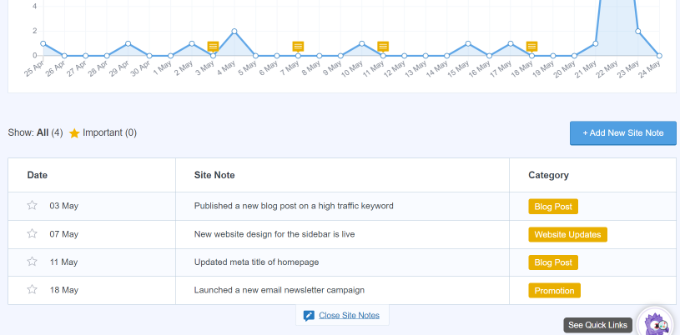
Aside from keeping traffic stats, MonsterInsights also helps you track user engagement, which is extremely useful in planning your content strategy.
If you’re just getting started, there’s also a free version of MonsterInsights available that you can try out.
Pros of MonsterInsights:
- Easy setup with no coding required
- Real-time traffic monitoring
- Detailed content performance reports
- User-friendly dashboard
- Track affiliate links and ads
Cons of MonsterInsights:
- Advanced metrics for tracking eCommerce stores and Google Ads conversion requires you to upgrade to the premium version
Why I recommend MonsterInsights: It’s the easiest way to use the power of Google Analytics to track your content performance. The best part? You can do it all from your WordPress dashboard. The detailed insights you can gain will help you make smarter decisions about your content strategy, and the free version gives you enough features to get started.
2. AIOSEO

Want to make sure your content reaches as many readers as possible? All in One SEO can help you create content that ranks well in search engines.
It’s a complete search engine optimization (SEO) toolkit that turns complex tasks into simple, actionable steps. Instead of struggling with technical SEO terms and complicated settings, it shows you how to easily make your content more SEO-friendly.
My team and I use AIOSEO on WPBeginner for XML sitemaps, on-page SEO, and schema markup to help search engines better understand our content. For more details, check out our in-depth AIOSEO review.
Another powerful AIOSEO feature I’ve noticed is the TruSEO On-Page Analysis. It gives you a simple checklist and scores your content so you can get more traffic to your posts.
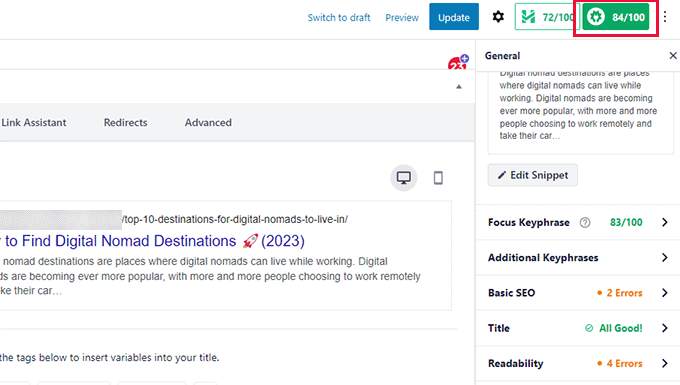
There’s also an Author SEO addon that lets you leverage author bios to showcase your expertise, experience, and authority. This helps you meet Google’s E-E-A-T guidelines and makes it easier for search engines to trust your content.
AIOSEO also offers rich snippets schema, social media integration, automatic internal linking, ChatGPT AI tools, a headline analyzer, and more.
For more on this topic, see our complete WordPress SEO guide with step-by-step instructions that will take your website SEO to the next level.
On a tight budget? AIOSEO’s free version has everything you need to start improving your SEO today.
Pros of AIOSEO:
- SEO audit checklist to optimize your website in seconds
- Simple setup and easy-to-understand SEO recommendations
- Social media optimization tools
- Built-in schema library
- Beginner-friendly interface
- Free version available
Cons of AIOSEO:
- To unlock full features, the premium version is required
Why I recommend AIOSEO: It makes SEO accessible to everyone while offering powerful tools for advanced users. The real-time content analysis helps you create SEO-friendly content from the start, and its automated features can save hours of technical setup time.
3. PublishPress

Managing multiple content creators, keeping track of deadlines, and maintaining consistent publishing schedules can be overwhelming. I’ve found that PublishPress can solve these challenges by streamlining your entire editorial workflow in WordPress.
With the PublishPress suite of plugins, your team can create an editorial calendar, schedule and manage WordPress revisions, and more. You can even customize WordPress permissions for editors or contributors.
We also tested the tool extensively when writing our complete PublishPress review, which you can check out for more details.
I especially liked the editorial calendar. It makes it easy to plan and schedule your content ahead of time. You can see all your drafts, scheduled posts, and published content in a familiar calendar view.

What makes PublishPress special is how it improves team collaboration.
I appreciate that you can create custom statuses, assign content to specific team members, and leave editorial comments right inside WordPress. This can help your team work better together and get content published faster.
The plugin also includes powerful features like content notifications, custom roles and capabilities, and revision management. You can control who can edit what, track content changes, and make sure nothing gets published without proper review.
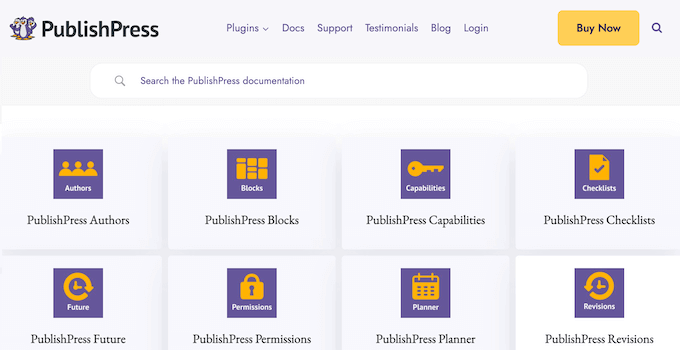
Keep in mind that PublishPress comes as a suite of separate plugins, so you can pick and install only the features you need for your workflow.
Pros of PublishPress:
- Visual editorial calendar for better planning
- PublishPress plugins come in separate free versions
- Custom post statuses to track content progress
- Built-in team collaboration tools
- Flexible permission controls
Cons of PublishPress:
- The PublishPress suite includes multiple plugins. This has its advantages, as you can buy only the specific tools you need. But installing and setting all of them up can be a bit tedious.
Why I recommend PublishPress: I know first-hand how challenging it can be to manage a growing blog with multiple authors. That’s why I always tell readers about PublishPress. If you’re working with a multi-author team or posting frequently, PublishPress is invaluable for staying organized and meeting deadlines.
4. Semrush

Struggling to outshine your competitors in search results? I know just how hard this can be. In my experience, Semrush is one of the best tools for uncovering competitor strategies and finding new opportunities to grow your traffic.
With Semrush, you can learn about your competitors’ top organic keywords, how they get backlinks, their advertising strategies, and more.
It also helps you monitor your own keywords and backlinks, find keywords that you can easily rank for, and get tons of other useful data that you can use to improve your content strategy.
Plus, my favorite part is its integration with AIOSEO, which lets you unlock tons of super handy features. For example, when you use both tools together, you can discover additional related keywords right from the WordPress editor.
💡 If you’re looking for a free alternative, try WPBeginner’s Keyword Generator. It instantly generates 300+ new keyword ideas from Google based on your main keyword.
You can also use WPBeginner’s free Keyword Density Checker to discover what keywords your competitors are optimizing for.
Pros of Semrush:
- Comprehensive keyword research tools
- Detailed competitor analysis
- Suggestions for content optimization
- SEO content templates to help create briefs
- Backlink monitoring and analysis
Cons of Semrush:
- Semrush’s pricing might be steep if you’re a beginner on a tight budget. However, they offer a 14-day free trial for you to test out the platform.
Why I recommend Semrush: Pick Semrush if you want a full-featured SEO suite with powerful tools for keyword research, competitor analysis, and content planning – all tied closely with on-page SEO.
5. Ahrefs

Building your site’s authority can be challenging, especially in competitive markets. Ahrefs gives you some of the most powerful tools for backlink analysis and content discovery, and I’ve seen how it can be a game-changer for lots of WordPress users.
It has a powerful crawler that monitors the web. I like this feature because you can use it to track your backlinks, search rankings, competitor backlinks, paid advertising keywords, and more.
Compared to Semrush, you might prefer Ahrefs if you’re more interested in backlinks, technical SEO audits, and uncovering gaps in your competitors’ content strategies.
It’s also a great choice if you want to strengthen your site’s authority since it can help you create content that fills gaps in the market.
Pros of Ahrefs:
- Powerful backlink analysis tools
- Accurate keyword difficulty scores
- Content gap analysis
- Competitor research features
- Site audit capabilities
Cons of Ahrefs:
- Ahrefs doesn’t have a free version or a free trial. But, they do have a free Webmaster Tools for you to get started
Why I recommend Ahrefs: It’s the go-to tool for understanding what content performs well in your industry. Ahrefs helps you find content opportunities your competitors missed, track your backlinks, and discover exactly what you need to improve your search rankings.
💡 Still not sure if you should use Semrush or Ahrefs? Check out my team’s detailed guide on Semrush vs Ahrefs vs Moz to find out which SEO tool is best for your needs.
6. Canva

Not everyone has the budget to commission professional images for their blog posts. That’s where Canva has been a lifesaver for me. It helps you create beautiful images for your blog posts like a pro without worrying about copyright.
Canva is, without a doubt, my go-to design tool. It’s got a powerful yet simple image editor that I can use right in my browser.
I love browsing through its impressive selection of templates, graphics, icons, banners, and infographics as starting points. Once I finish tweaking my design, I just export the image and pop it into my articles.
Canva also has a cool feature where I can use AI to generate images just from a description.

Best of all, you can embed your Canva designs directly into WordPress posts and pages. This saves time and makes your content creation workflow smoother.
All that said, if you’re looking for more powerful design tools, you can check out the best Canva alternatives for website graphics.
What’s even better is that I can embed my Canva designs directly into WordPress posts and pages. This really saves me time and makes my content creation process so much smoother.
Pros of Canva:
- Easy drag-and-drop design tools
- Huge library of templates and elements
- WordPress embedding feature
- Team collaboration features
- Brand kit storage
- Free version available
Cons of Canva:
- Although the free version has a lot, some premium templates and elements require a Pro subscription. But honestly, the time I save creating professional images makes it worth the investment for serious content creators.
Why I recommend Canva: In my experience, Canva takes the stress out of making visual content. Whether you need blog images, social media graphics, or infographics, Canva makes it easy for anyone to whip up professional-looking designs in no time.
7. Novashare
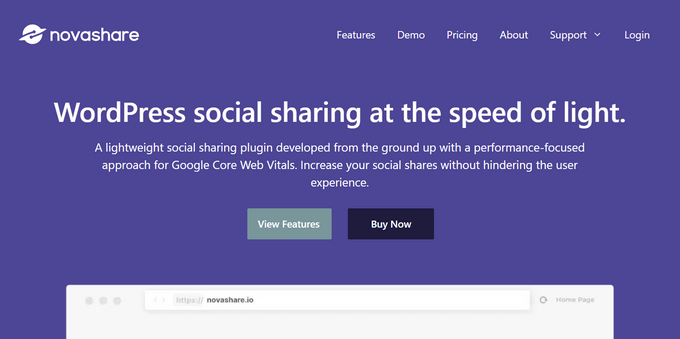
Novashare is a fast and lightweight social sharing plugin that helps you get more traffic from social media. It makes it easy to add social sharing buttons to your content so you can reach as many people as possible.
One standout feature is Novashare’s share count tracking. It allows you to easily display how many times my posts have been shared across different platforms. This helps add social proof to boost my credibility and encourage even more shares.

Check out my team’s detailed Novashare review to learn more about all its features.
What makes Novashare special is its focus on performance. Unlike other social sharing plugins, it doesn’t load any third-party resources and uses SVG icons, which means your site stays fast while still showing accurate share counts.
I appreciate that Novashare supports over 25 social networks. That way, you can really maximize your reach. It also gives you complete control over button placement and design, and is fully mobile-responsive to look great on any device.
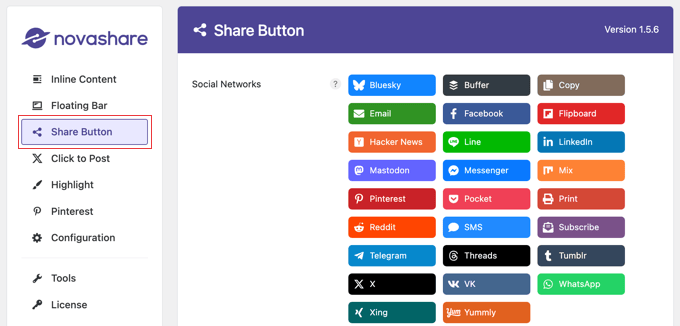
You can also add a share button for any supported social network with just a few clicks, making it easy to customize your sharing options.
Pros of Novashare:
- Fast and lightweight performance
- Over 25 social sharing icons
- Mobile-responsive buttons
- Easy setup and customization
- Social share count tracking
- GDPR compliant
Cons of Novashare:
- While Novashare is a premium plugin with no free version, it’s affordably priced, starting at $19.95 per year
Why I recommend Novashare: In my experience, this is the best and fastest social sharing plugin. From customizable sharing buttons to Click to Tweet blocks, Novashare makes it easy for me to spread my content across social platforms.
8. Grammarly

Grammarly is a real-time writing assistant that catches grammar, spelling, and style mistakes as you create content. My team and I have used it extensively, and we love how it works seamlessly in the WordPress editor and any writing area across the web.
Simply install it as a browser extension, and you’ll have what feels like a professional editor checking your content 24/7. This way, you can easily improve your content.
After you set up Grammarly, it will show an indicator at the bottom right corner of your writing area. Clicking on the indicator will show you the number of errors. Spelling, grammar, and contextual errors will be highlighted with an underline as you write.
For more details, read our guide about using Grammarly to check for grammar and spelling mistakes.
Pros of Grammarly:
- Real-time grammar and spell checking
- Style and tone suggestions
- Works in WordPress editor and everywhere else
- Vocabulary enhancement suggestions
- Readability score feedback
Cons of Grammarly:
- You’ll need the premium version for advanced features like style suggestions and plagiarism detection
Why I recommend Grammarly: It’s like having a professional editor review your content 24/7. Whether you’re writing blog posts, emails, or social media updates, Grammarly helps you create polished, error-free content.
9. EWWW Image Optimizer

In my opinion, EWWW Image Optimizer is one of the best image compression plugins that helps your WordPress site load faster. It automatically compresses your images without damaging their quality, which is essential for your site’s speed and performance.
When I tested it myself, I found it very easy to use. And you don’t have to worry about a confusing setup.
What makes it special is how EWWW Image Optimizer handles optimization. It can automatically scale images for different devices, enable lazy loading, and convert images to modern WebP and AVIF formats.
I also appreciate that the plugin works with all common image types, including JPG, PNG, GIF, and even PDF files. It even keeps backups of your original images for 30 days, giving you peace of mind when optimizing your content.
Pros of EWWW Image Optimizer:
- Automatic image compression
- Supports WebP and AVIF formats
- Keeps original image backups
- Lazy loading feature
- Works with all common image types
- Bulk optimization tool
Cons of EWWW Image Optimizer:
- The free version handles basic compression, but premium features like WebP conversion require a paid upgrade
Why I recommend EWWW Image Optimizer: This plugin is great for anyone who runs a WordPress site with lots of images. It helps your site load faster, rank better in search engines, and provide a better user experience. Plus, its automatic optimization features save you time and ensure all your images are properly compressed.
10. ClickSocial

Are you juggling multiple social media accounts? I’ve done this myself, and I know how hard it can be. If you don’t have the right tools, it can start to feel like a full-time job! That’s where ClickSocial can be a lifesaver.
With it, you can manage your social media posts effortlessly, right from the WordPress dashboard. You can connect with platforms like Facebook, Instagram, and Twitter (X) seamlessly.
Managing your posts is straightforward yet flexible, since you get smart scheduling times. Plus, the post editor is highly intuitive. Check out my team’s full review of ClickSocial to learn more about its features.

On top of all the essential scheduling and editing features, I also really love ClickSocial’s collaboration tools.
For example, it lets team members submit posts for approval and allows you to leave feedback on drafts. You can even assign certain team members to certain social media accounts.
Pros of ClickSocial:
- Easy setup and intuitive post editor
- Seamless integration with WordPress
- Supports major social media platforms
- Built-in calendar for easy scheduling
- Collaboration tools for team management
Cons of ClickSocial
- It doesn’t come in a free version
Why I recommend ClickSocial: It’s a game-changer for anyone trying to keep up with social media without the stress. It also has some fantastic team collaboration tools that can boost productivity.
11. PushEngage
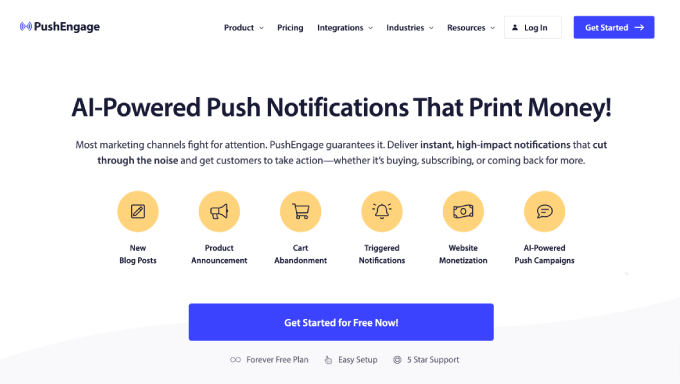
PushEngage is a powerful push notification plugin that helps you bring visitors back to your WordPress site.
Here at WPBeginner, my team and I used it to build and refine our push notification strategy. It eventually helped us increase our return traffic and drive 10,000 extra visitors to our site.
To learn more about our experiences with the plugin, see our detailed PushEngage review.
With its easy-to-use interface, PushEngage lets you send timely notifications to your subscribers whenever you publish new content. You can customize your messages, schedule notifications, and segment your audience to get better engagement.
One feature I particularly appreciate is PushEngage’s smart targeting capabilities. You can use it to set up automated notifications for things like cart abandonment, run A/B tests to optimize click rates, and even segment subscribers based on their behavior patterns.
Plus, its analytics can help you track exactly how well your notifications perform.
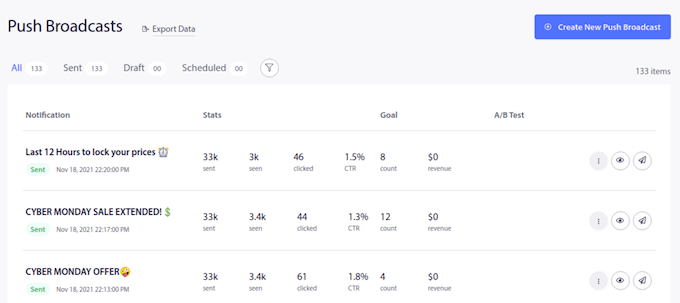
Special for WPBeginner readers, PushEngage offers a 35% discount. It automatically selects the Business plan with up to 50,000 subscribers and unlimited campaigns.
Pros of PushEngage:
- User-friendly editor with easy setup and customization
- Automated push notifications
- Audience segmentation features
- Detailed analytics and tracking
- Push notifications for cart abandonment
Cons of PushEngage:
- PushEngage’s free plan has limited features, and you’ll need a paid plan for advanced features
Why I recommend PushEngage: I really appreciate PushEngage for its simplicity and powerful features. Whether you’re a beginner or more advanced, this tool is perfect for anyone looking to grow their traffic.
12. LowFruits
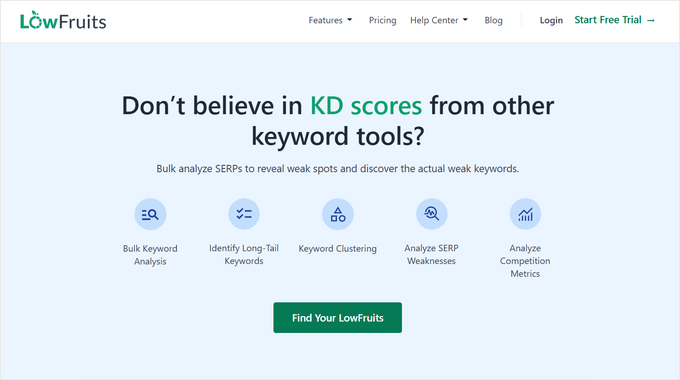
LowFruits is a keyword research tool specifically designed for content marketers and SEO professionals. Unlike other keyword tools, LowFruits focuses specifically on identifying “low-hanging fruit” keywords – those with lower competition and higher potential for ranking.
My team and I use it almost every day to find keywords, track keyword rankings, and more. It’s helped us immensely when optimizing our blog content.
I’ve found it particularly useful for uncovering long-tail keywords and niche topics that larger competitors often overlook. It empowers you to discover untapped opportunities to attract targeted traffic to your WordPress site.
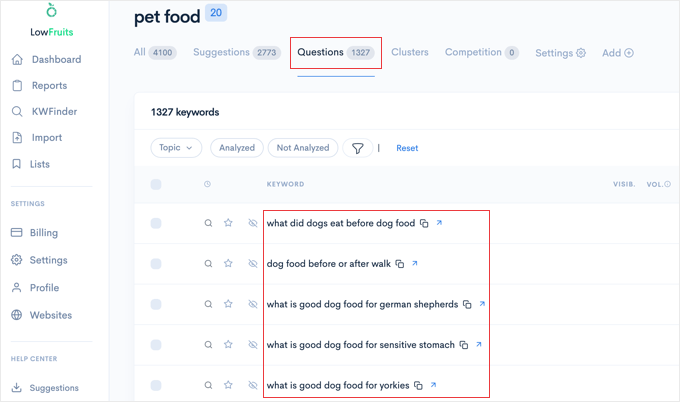
The best part? LowFruits simplifies keyword research with its easy-to-understand keyword difficulty scoring. This feature helps you quickly assess the ranking potential of different keywords, saving you valuable time and effort.
You can also analyze your competitors’ keyword strategies to identify gaps in their content, giving you a competitive edge.

To further refine your content, you can use LowFruits’ SERP analyzer to examine the top-ranking pages for your target keywords. This way, you can understand what type of content resonates with both search engines and users.
Best of all, LowFruits integrates seamlessly with AIOSEO, allowing you to research and optimize keywords directly within your WordPress editor, streamlining your content creation workflow.
Pros of LowFruits:
- Helps you identify keywords that are easier to rank for
- Intuitive and beginner-friendly interface
- Provides data-driven recommendations for content creation and optimization
Cons of LowFruits:
- May not have the same amount of keyword data as more comprehensive SEO suites
- Doesn’t offer features for other aspects of SEO, such as backlink analysis or site audits (but you can pair it with AIOSEO)
Why I recommend LowFruits: If you’re struggling to compete for high-volume keywords, LowFruits is a fantastic option. It empowers you to find niche topics and long-tail keywords that are easier to rank for. Its integration with AIOSEO further streamlines your workflow, enabling you to optimize your content directly within WordPress.
13. OptinMonster
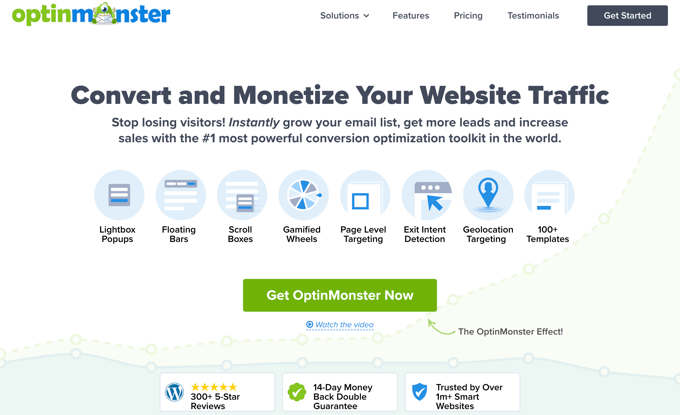
OptinMonster is a complete lead generation toolkit that turns casual visitors into loyal subscribers and customers. At WPBeginner, my team used OptinMonster to increase our email subscribers by 600%, so we can confidently recommend it.
For in-depth details and information on what the tool can do, check out our complete OptinMonster review.
With its drag-and-drop builder, you can use OptinMonster to build your email list by choosing from over 400 pre-built templates and customizing them to match your website’s design.

I also love OptinMonster’s targeting features. You can show different campaigns based on user behavior, like when someone’s about to leave your site or has been inactive for a while.
This helps you reduce bounce rates, increase engagement, and lower cart abandonment.
Best of all, OptinMonster comes with advanced targeting features like Exit Intent technology, which detects when visitors are about to leave and shows them a targeted message.
Pros of OptinMonster:
- Easy drag-and-drop builder
- 400+ pre-built templates
- Smart targeting features
- Exit Intent technology
- A/B testing capabilities
- Mobile-responsive designs
Cons of OptinMonster:
- There is no free version of the OptinMonster plugin
Why I recommend OptinMonster: In my opinion, it’s the most powerful way to turn your WordPress site visitors into subscribers and customers. With it, you can easily create pop-up forms, floating bars, and full-screen welcome mats that convert more visitors into leads.
What Are the Best Content Marketing Tools and Plugins for WordPress?
Content marketing involves many different tasks, so I’ve picked the best tool for some of the most important tasks you’ll need to do when creating and sharing content.
MonsterInsights offers the best way to track how well your content is doing. It shows your Google Analytics data right in WordPress, so you can easily see which posts are popular without having to learn complex analytics tools.
AIOSEO is your best choice for getting your content to rank higher in search results. It helps you write better titles and descriptions, create XML sitemaps, audit your content, and so much more. I also recommend pairing it with LowFruits to improve your keyword strategy.
PublishPress makes it easy to plan and publish your content. It gives you an editorial calendar to see all your posts, lets you set up custom status labels, and sends alerts to your team when it’s time to work on content.
Canva helps you make great-looking images without being a graphic designer. You can create pictures for your blog posts and social media right from WordPress using simple drag-and-drop tools that anyone can use.
ClickSocial simplifies managing your social media presence. It integrates with WordPress to let you schedule and automate posts across major platforms like Facebook and Instagram.
FAQs About Content Marketing Tools and Plugins
Here are the most frequently asked questions related to content marketing tools and plugins that can help you out.
What is the best content marketing tool or plugin?
There isn’t a single best content marketing tool since different tasks need different solutions. You’ll need a combination of tools to handle SEO, social media, analytics, and content planning.
For those categories in particular, we recommend All in One SEO, Novashare, MonsterInsights, and PublishPress. But the key is picking tools that match your specific needs and work well together for your content strategy.
How can content marketing tools help me grow my website?
Content marketing tools help you create better content faster, optimize it for SEO, promote it on social media, and track your results. With the right tools, you can reach a wider audience, drive more traffic to your site, and build stronger relationships with your readers.
Are free content marketing tools enough to get started?
Yes, many free content marketing tools offer everything you need when you’re just starting out. For example, some of our favorite content marketing plugins come in free versions. These include All in One SEO, MonsterInsights, and PushEngage.
As your site grows, you might want to invest in premium tools to unlock advanced features that can save you more time and deliver even better results.
Bonus Content Marketing Tools
Before you go, check out these extra tools for your consideration:
- ThirstyAffiliates – It’s a great WordPress plugin for managing affiliate links and maximizing the revenue from your website.
- Beacon – Free and easy-to-use software for creating professional lead magnets like eBooks, checklists, workbooks, and libraries of gated content.
- MemberPress – Top WordPress membership plugin that helps you create and sell online courses, premium content membership, and more.
- Missed Schedule Post Publisher – This plugin helps ensure that your scheduled posts are always published on time.
- TrustPulse – This tool sets you show social proof notifications for your content.
We hope this article helped you find the best content marketing tools and plugins for your WordPress website. You may also want to see our actionable tips on driving more traffic to your WordPress blog, and our guide on how to curate content automatically.
If you liked this article, then please subscribe to our YouTube Channel for WordPress video tutorials. You can also find us on Twitter and Facebook.



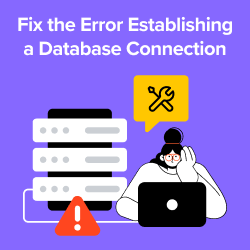

Jiří Vaněk
Great list. I use some of these tools and can’t imagine working with WordPress without them. First and foremost, there’s AIO SEO, which helps me with the SEO promotion of my websites. Monster Insights is essential for better understanding what Google Analytics is telling me; without it, I would be lost in a sea of numbers. Last but not least, I rely on Grammarly for proofreading my English texts, which I use as a translator.
As for the other tools, I’ve tried some, but others are new to me, and I’m definitely looking forward to checking them out. I use Semrush on a free account and don’t have the paid version. Recently, I’ve heard a lot of praise for Ahrefs, and I’d like to give it a try. I just sometimes regret that these tools are quite costly for the budget, and even though they are excellent, they significantly strain the website’s monthly budget.
Moinuddin Waheed
Great list of plugins and software tools for marketing.
I have been using many of these like grammarly, canva, AIOSEO, shared count and others.
They are very useful and makes the whole process of online presence making a cakewalk.
for instance, grammarly is always there if you make any spelling or grammatical mistakes making you an expert in the language although you are not.
similarly canva makes the images and graphics options intuitive and easy.
The complete list is must have for growing online business and marketing.
Kabsha Majid
I have personally used Grammerly, Ahrefs, and Canva and they are really amazing. It’s a good list of plugins to work with.
WPBeginner Support
Thanks for sharing the ones that you use
Admin
Diana Swaney
Thank you very much!
WPBeginner Support
You’re welcome
Admin
Wadiyo
Thank for your information, great!
How about Jetpack?
Sincerely